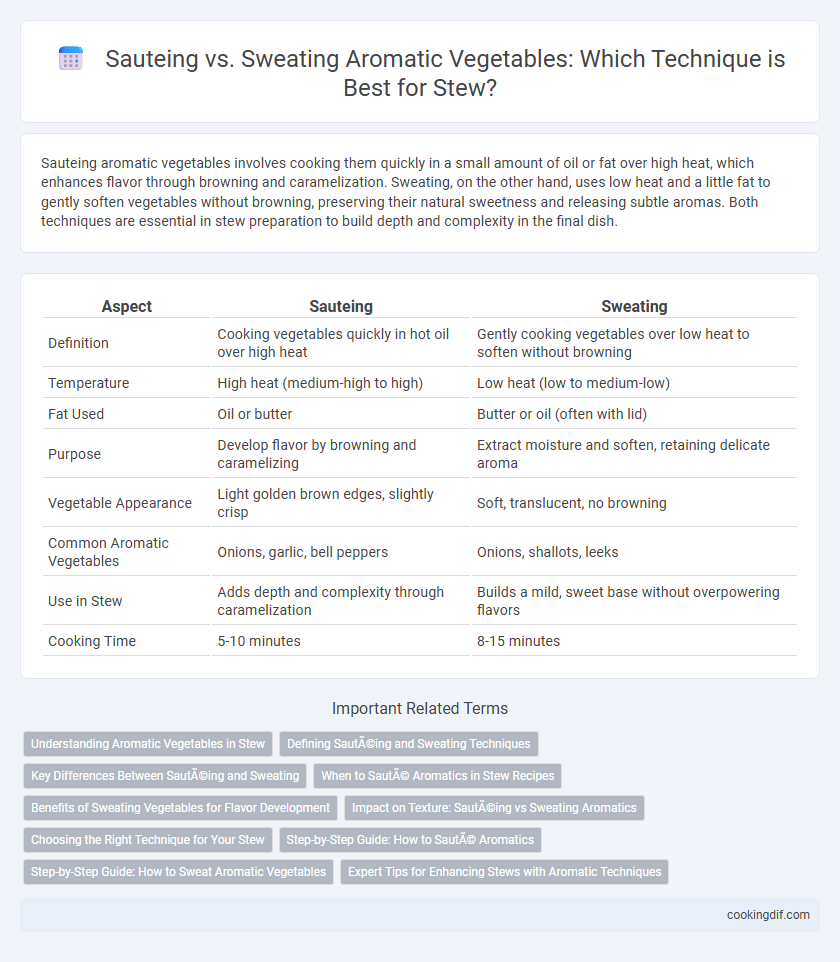Sauteing aromatic vegetables involves cooking them quickly in a small amount of oil or fat over high heat, which enhances flavor through browning and caramelization. Sweating, on the other hand, uses low heat and a little fat to gently soften vegetables without browning, preserving their natural sweetness and releasing subtle aromas. Both techniques are essential in stew preparation to build depth and complexity in the final dish.
Table of Comparison
| Aspect | Sauteing | Sweating |
|---|---|---|
| Definition | Cooking vegetables quickly in hot oil over high heat | Gently cooking vegetables over low heat to soften without browning |
| Temperature | High heat (medium-high to high) | Low heat (low to medium-low) |
| Fat Used | Oil or butter | Butter or oil (often with lid) |
| Purpose | Develop flavor by browning and caramelizing | Extract moisture and soften, retaining delicate aroma |
| Vegetable Appearance | Light golden brown edges, slightly crisp | Soft, translucent, no browning |
| Common Aromatic Vegetables | Onions, garlic, bell peppers | Onions, shallots, leeks |
| Use in Stew | Adds depth and complexity through caramelization | Builds a mild, sweet base without overpowering flavors |
| Cooking Time | 5-10 minutes | 8-15 minutes |
Understanding Aromatic Vegetables in Stew
Sauteing aromatic vegetables in stew involves cooking them over high heat with oil to develop rich caramelization and deepen flavors, while sweating gently softens the vegetables over low heat, releasing subtle aromas without browning. Common aromatic vegetables like onions, garlic, carrots, and celery benefit from sweating to create a flavorful base that enhances the stew's complexity. Choosing between sauteing or sweating depends on the desired intensity and clarity of the stew's aromatic profile.
Defining Sautéing and Sweating Techniques
Sauteing aromatic vegetables involves cooking them quickly over high heat with a small amount of fat to develop a golden-brown color and intensified flavor. Sweating, in contrast, uses lower heat and gentle cooking with a lid to soften vegetables and release moisture without browning. Both techniques are essential in stew preparation, influencing the depth of flavor and texture in the final dish.
Key Differences Between Sautéing and Sweating
Sauteing involves cooking aromatic vegetables over medium-high heat with oil or butter, creating a caramelized exterior that enhances flavor through browning. Sweating uses low heat and a covered pan to soften vegetables without color, releasing moisture and developing sweetness gently. The key difference lies in the temperature and moisture control, with sauteing aiming for texture and color, while sweating emphasizes softening and flavor extraction.
When to Sauté Aromatics in Stew Recipes
Saute aromatic vegetables like onions, garlic, and celery in stew recipes when aiming to develop deep, rich flavors through caramelization and browning. This technique is ideal at the beginning of the cooking process to create a robust flavor base by quickly cooking the aromatics over medium-high heat. For stews that require longer simmering times, sauteing enhances the complexity and depth of the final dish.
Benefits of Sweating Vegetables for Flavor Development
Sweating aromatic vegetables gently in a covered pan at low heat releases their natural moisture, which helps to soften them without browning, preserving their delicate flavors. This technique enhances the overall stew by allowing the vegetables to meld seamlessly into the base, creating a subtle, savory depth crucial for complex flavor profiles. By avoiding caramelization, sweating maintains a fresh, aromatic quality that forms a balanced foundation for rich, slow-cooked stews.
Impact on Texture: Sautéing vs Sweating Aromatics
Sauteing aromatic vegetables in stew creates a caramelized exterior and firmer texture due to higher heat and faster cooking, enhancing depth and complexity in the dish. Sweating aromatics uses low heat and moisture to soften vegetables without browning, resulting in a tender, mellow base that integrates smoothly into the stew. Choosing between sauteing and sweating directly impacts the stew's overall texture and flavor intensity, influencing the final mouthfeel and aromatic profile.
Choosing the Right Technique for Your Stew
Sauteing aromatic vegetables involves cooking them quickly over high heat with oil, which enhances their flavor through caramelization and browning, ideal for stews that require a robust, deep taste. Sweating, on the other hand, uses low heat and minimal fat to soften vegetables gently, preserving their natural sweetness and releasing subtle aromas without color, making it perfect for delicate, broth-based stews. Selecting between sauteing and sweating depends on the desired flavor intensity and texture, ensuring your stew achieves the optimal balance and depth.
Step-by-Step Guide: How to Sauté Aromatics
To saute aromatic vegetables, heat oil over medium-high heat until shimmering, then add chopped onions, garlic, and celery, stirring frequently to achieve a golden-brown color that enhances flavor through caramelization. Maintain consistent heat to avoid steaming and ensure moisture evaporates quickly, allowing Maillard reactions to develop complex, savory notes ideal for stews. Adjust heat as needed and cook aromatics until translucent and fragrant, typically 5 to 7 minutes, creating a rich flavor base.
Step-by-Step Guide: How to Sweat Aromatic Vegetables
Sweating aromatic vegetables involves cooking them gently over low heat with a small amount of fat, usually oil or butter, to soften without browning, preserving their delicate flavors and moisture. Begin by heating the pan on low, adding fat, then stirring in diced onions, carrots, celery, or garlic, cooking until they become translucent and tender, usually 5-10 minutes. This technique is essential in stew preparation to build a deep, harmonious flavor base before adding liquids or other ingredients.
Expert Tips for Enhancing Stews with Aromatic Techniques
Sauteing aromatic vegetables like onions, garlic, and carrots in hot oil caramelizes their sugars, intensifying flavors and adding depth to stews. Sweating, cooking these vegetables gently in a covered pan with minimal fat, softens them and releases subtle sweetness without browning, creating a delicate base. Expert cooks balance these techniques by initially sweating to build aroma, then briefly sauteing to develop complexity, elevating the stew's overall richness.
Sautéing vs Sweating for aromatic vegetables Infographic

 cookingdif.com
cookingdif.com